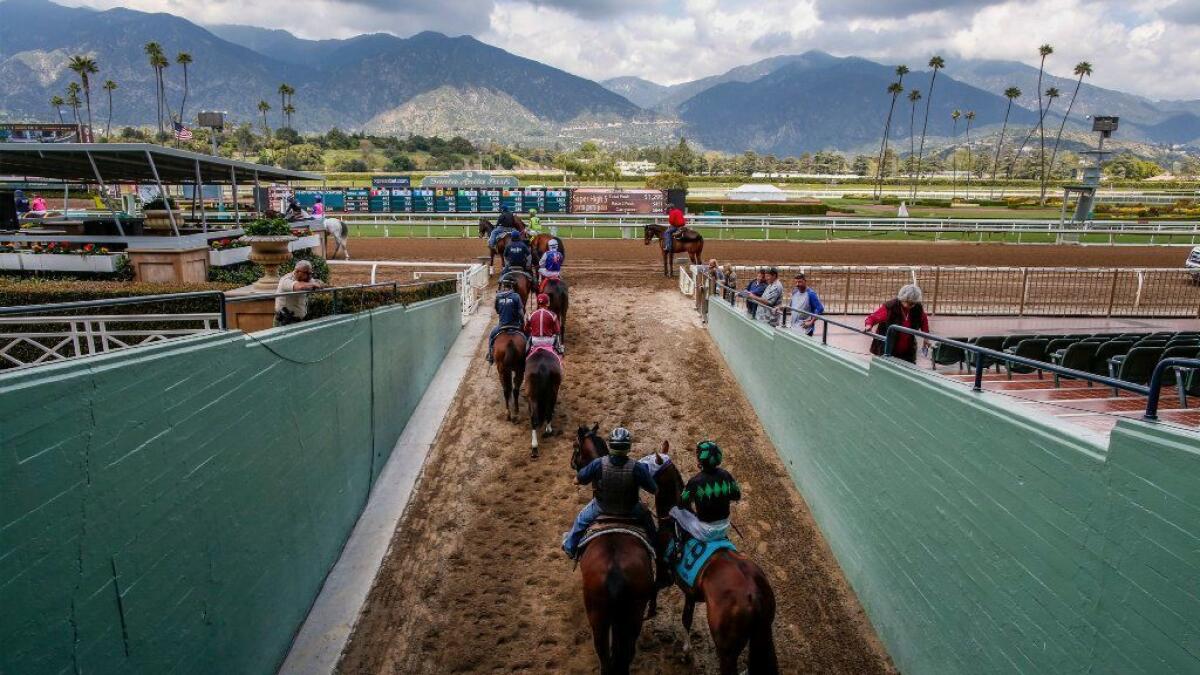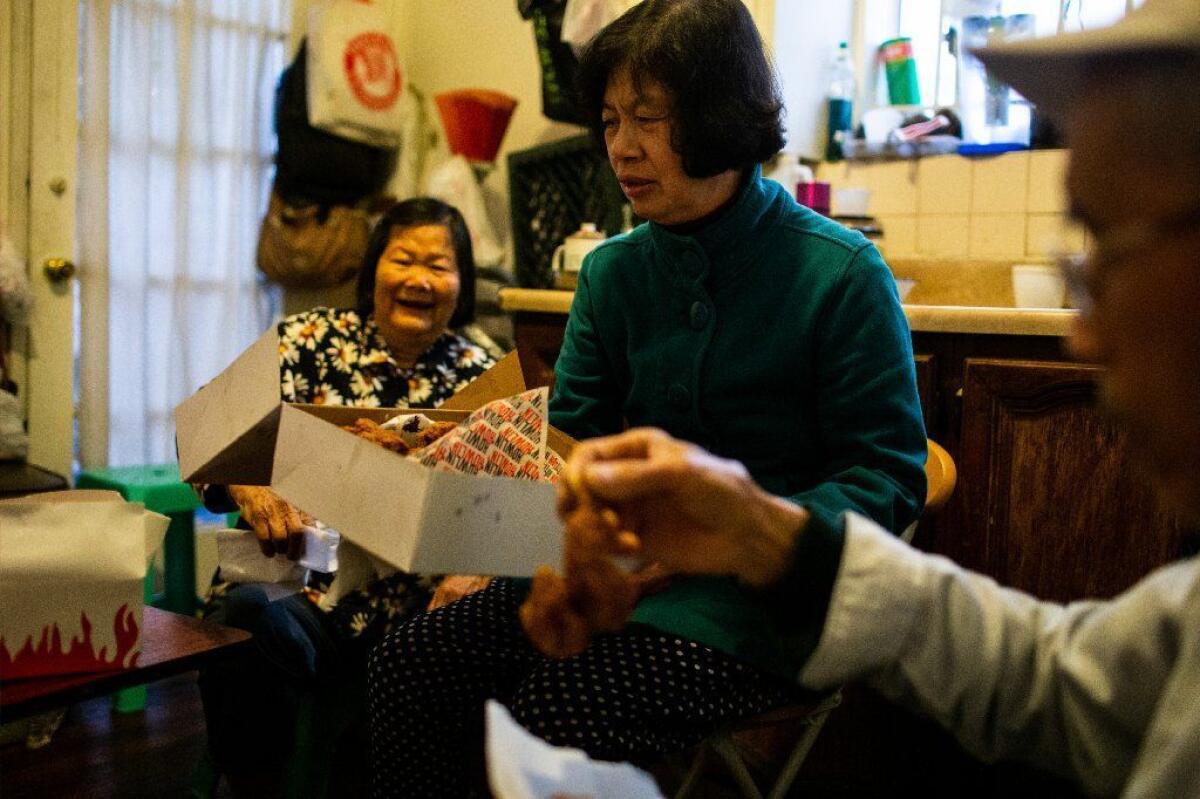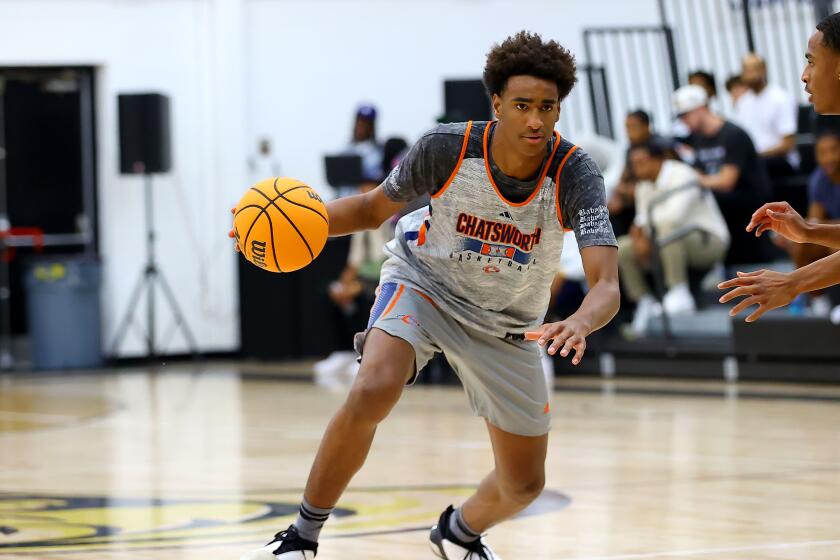Newsletter: Essential California: Why do horses keep dying at Santa Anita racetrack?
- Share via
Good morning, and welcome to the Essential California newsletter. It’s Tuesday, May 28, and I’m writing from Los Angeles.
On Sunday, another horse died at Santa Anita Park in Arcadia — the 26th horse to die racing or training at the track since late December. The mounting equine death toll at the Southern California track has generated national headlines and calls from animal rights groups to suspend racing. Racing at the famed track was suspended for most of March for an investigation after the deaths of 22 horses in a little more than two months, but it resumed at the end of the month. Yesterday, Sen. Dianne Feinstein of California renewed her call for a moratorium on racing at Santa Anita.
So, why do horses keep dying at the state’s preeminent race track? And what do the deaths and scrutiny mean for an industry that’s long past its halcyon days?

Veteran Los Angeles Times sports reporter John Cherwa has been on the horse racing beat for the last four years and writes a regular horse racing newsletter. He picked up his phone yesterday from the press box overlooking the track at Santa Anita, where he was getting ready to cover three major races.
Has anything like this happened before?
Yes, it happened a couple of years ago at Del Mar. It’s happened at Aqueduct in New York and Saratoga in New York. I don’t want to say these clusters are common, but they’re also not terribly unusual.
Was there a similar outcry around those previous clusters of horse deaths?
I don’t think it was as intense as it is here. American society has evolved through the years to the point where animals have a higher place in the heart than they did in the past. Plus, it’s California, which is a pretty progressive state. When this happens in Kentucky, people don’t think a lot about it, because people in Kentucky understand and accept the fact that horses die in horse racing. In California, people may not accept that quite as easily.
When it happened in New York, they were able to determine what the problem was. Here in California, they have some theories but they haven’t figured it out yet.
What are the theories for why this keeps happening at Santa Anita?
A lot of people keep bringing up the weather. There was 20-plus inches of rain over a very short period of time. On the surface that makes sense, but we’ve had rain in California before and you didn’t have these sort of things happening. An outgrowth of the rain is that they’ve been “sealing the track,” which essentially means they press it down really hard, so that water can’t seep into the ground. But that makes for a very hard surface. Some have speculated that the horses have contracted micro-fractures while running on that very hard surface. Those micro-fractures may not immediately show up, but maybe two or three races down the road it suddenly happens and you get the breakdowns. [“Breakdown” doesn’t necessarily mean a fatality. It’s a racing industry term that refers to “a catastrophic injury.”]
The Los Angeles district attorney’s office has assigned investigators to work with the California Horse Racing Board to investigate these deaths. But who oversees horse racing as an industry as whole?
That’s one of the problems with horse racing. There is no national body. It is run state-to-state and every state is different. Within the industry, there are three major players, and even they can’t get together and agree on anything. It’s on this backdrop of great dysfunction that horse racing exists.
How does California compare with other states in terms of regulations?
Currently, California is probably the most heavily regulated state, because they just implemented a lot of new medication rules. They’re even exploring the idea of eliminating the whip, which is euphemistically called the riding crop.
Do these regulations actually make racing safer?
The measures that they’ve put in place really have no direct correlation to breakdowns. Like eliminating or reducing the amount of Lasix [a common anti-bleeding medication] a horse can take on race day. There’s really no scientific evidence that says that Lasix has anything to do with breakdown. There is no evidence that riding crops or whipping of your horse has any correlation to breakdowns. But what they’re really dealing with right now is a public perception problem. Do people want horses running on medication? Do people want to see jockeys striking horses? The answer to those questions is no. And that’s why the rules they’ve implemented are more designed to help public perception than get to the root of the problem.
Not to sound crass, but how many horses typically die during a regular season? What’s a “normal” number?
The metric that they use is in starts per thousand. California tracks are usually about 1.8 starts per thousand. So, for every thousand horses that start a race, somewhere around 1.8 die, or are involved in a fatal accident. They’ve reduced the number of fatalities by 60% in the last decade and half.
The reason the metric is measured that way is because it depends on the number of racing days you have. If you were to race 12 months a year, you would have a pretty big number. If you were to race two weeks a year, [you may not see any fatalities].
The thing is, if you’re going to have horse racing, horses are going to die. It is inevitable. The goal, of course, is to get to zero fatalities. That’s probably never attainable, no more than [it would be] driving on the road or flying on a plane or playing football, for that matter. But the number is high.
How healthy is the horse racing industry today, compared with where it was a generation or two ago?
It’s a shadow of itself. There were times back in the ’50s or ’60s, maybe even the ’70s, where on just an average weekend you’d have 40,000 people at a race track. Now, a really big crowd would be 20,000 people. Horse racing was the only legal form of gambling for a long time. So, if you wanted to gamble, this is where you came. It was huge. But the horse racing industry has been struggling. How long it will continue to exist — I don’t know. But if they don’t get their safety issues under control, it’s not going to be as long as they want it to be.
[Go deeper: “Racing experts discuss the future of the sport after rash of horse deaths at Santa Anita” by John Cherwa]
It would probably take a ballot referendum to abolish horse racing in California. Is that a possibility right now?
It would be a tall order. First of all, you need 635,000 signatures, which really means you need a million signatures because signatures get thrown out. The industry would easily put $50 million to a $100 million into opposing that kind of ballot measure. And not a lot of people really have an opinion or care about horse racing. If you don’t care or know about something on a ballot measure, human nature is to vote no. Plus, the animal rights community would need a few sugar daddies out there who would have to pony up a lot of money to try to compete with this.
The horse racing industry is very scared of a ballot initiative, but I think if you look at it dispassionately, you’d see that the hill would be pretty high to climb.
And now, here’s what’s happening across California:
TOP STORIES
Southern California home prices are rising four times faster than wages. And the number of renters is growing three times faster than homeowners as would-be homebuyers increasingly are priced out of the market. Los Angeles Daily News
A wave of “disaster tourists” has descended on Paradise after California’s deadliest wildfire. Driven by a “mix of morbid curiosity and compassion,” they wander the wreckage and share photos of the destruction on Instagram. San Francisco Chronicle
Get the Essential California newsletter »
L.A. STORIES
Looking for parking in Koreatown is a “blood sport.” The neighborhood is Los Angeles County’s densest area, with 40,000 people jammed into each square mile, and the parking situation has grown so dire that residents plan much of their lives around the daily battle for spots. Los Angeles Times
How the Beatles ended up at a Brentwood garden party in 1964. Los Angeles Magazine

Many longtime Chinatown locals have never tried Howlin’ Ray’s, the neighborhood’s most popular restaurant, so columnist Frank Shyong brought the food to them. Los Angeles Times
Your support helps us deliver the news that matters most. Subscribe to the Los Angeles Times.
POLITICS AND GOVERNMENT
Should California force priests to report child-molestation confessions? State lawmakers are considering a bill that would force clergy who hear confessions of child sex abuse from another priest to report it. Mercury News
Think California’s too big and influential? Wait until the presidential race heats up. Los Angeles Times
Rep. Duncan Hunter (R-Alpine) has acknowledged taking a photo with a dead combatant during his time as a Marine. Hunter made the comments while defending Navy SEAL Chief Eddie Gallagher, a soldier accused of war crimes. “Eddie did one bad thing that I’m guilty of too — taking a picture of the body and saying something stupid,” the congressman said at a forum. Times of San Diego
CRIME AND COURTS
As Oakland seeks justice in the deadly Ghost Ship fire trial, “the soul of the city” has also been put on trial. Washington Post
What can happen when the very people you’d call for help know, and even work with, your abuser? The California-based 9th U.S. Circuit Court of Appeals is considering whether responding police officers can be held accountable for repeated failures to arrest an officer accused of domestic violence. KQED
THE ENVIRONMENT
San Diego County health officials have closed Imperial Beach’s entire shoreline to swimmers after sewage from Tijuana flowed north from Mexico. A partial closure had already been in place. San Diego Union-Tribune
An internet-famous baby bald eagle has died of suspected hypothermia near Big Bear Lake. Los Angeles Times
CALIFORNIA CULTURE
A new San Francisco program will offer free general admission to more than a dozen museums and cultural centers for low-income residents who receive public benefits. KQED
What the new Star Wars: Galaxy’s Edge means for Disneyland, Anaheim and the greater Disney universe. Orange County Register
Major League Baseball veteran Bill Buckner, who made his debut with the Dodgers in 1969, has died at 69. Los Angeles Times
Culture writer Anne Helen Petersen quite literally has her PhD in celebrity gossip (well, technically the degree probably says media studies, but her research focused on “the industrial history of the gossip industry”) and her stories often tackle pop subject matter with academic rigor. In her latest long-form essay, Petersen looks at how actress Kate Hudson “pivoted to leggings” as her film career plateaued. But the piece also explores myriad big themes, including the celebrity endorsement industrial complex, wellness culture and the options available for post-ingenue women in Hollywood. BuzzFeed
A homeless man saved a stranded baby shark near a popular San Clemente surf spot. Orange County Register
East Bay-ers living in the 510 area code will soon have to dial 1 plus the area code to call other 510 locals, or nearby numbers assigned the new 341 area code. SF Gate
A new ax-throwing business has opened near Joshua Tree. Desert Sun
CALIFORNIA ALMANAC
Los Angeles: partly sunny, 69. San Diego: partly sunny, 67. San Francisco: partly sunny, 65. San Jose: sunny, 73. Sacramento: sunny, 84. More weather is here.
AND FINALLY
Today’s California memory comes from Jim Clarke:
“Although I grew up in the East Bay area, our family was very excited about the opening of Disneyland in 1955. I was 6 years old. The family decided to take a road trip to Anaheim. My mother had sewn a shirt for me consisting of wide blue and white stripes like the awnings at Disneyland. I remember we stayed the night before at the Candy Cane Motel in Anaheim. The next day was very crowded, but there were not a lot of rides and attractions. I was still excited in my blue-and-white striped shirt. At some point, I bent down and started throwing small pebbles into a small stream (like boys my age were prone to do). Then, I heard a voice behind and above me telling me to stop doing that. I looked up, directly into the sun, squinted but was able to distinguish who was chastising me. It was Walt Disney himself. My God, Walt Disney was yelling at me. Think I remain traumatized even today. I have returned to Disneyland many times since but don’t throw any pebbles into the lake.”
If you have a memory or story about the Golden State, share it with us. (Please keep your story to 100 words.)
Please let us know what we can do to make this newsletter more useful to you. Send comments, complaints, ideas and unrelated book recommendations to Julia Wick. Follow her on Twitter @Sherlyholmes.
More to Read
Go beyond the scoreboard
Get the latest on L.A.'s teams in the daily Sports Report newsletter.
You may occasionally receive promotional content from the Los Angeles Times.











